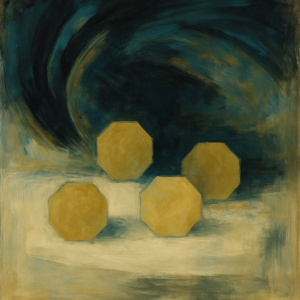I was making biscotti this weekend. The dough was too dry, and I immediately thought maybe I was reading an AI-generated recipe. This first reaction bothered me—how can we ever know when something is authentic when the markers of authenticity are stolen by the more powerful and used to dress up their own product?
AI images try to look authentic as if a real person made them.
AI can make 10-second-to-generate paintings with hand-made qualities that mimic hours of labour, just like an ad for mass-produced chocolate can features small-town artisans chasing their dreams.
“In the craftsman’s workshop, handmade products took great efforts, skills, and time to produce. The merchant’s mark was a personal guarantee of quality by the workshop’s master. The invention of the steam engine set in motion industrial production in the late eighteenth century, and the market would soon be flooded with identical mass-produced goods. These products were of much lower quality than the handmade products, and their form revealed little about the people who designed and produced them, and under which circumstances. To compensate for the absent affinity that craftsmen instilled in their products, artists were hired to invent narratives, names, and symbols to replace the craftsmen’s signature.” “By using a consistent way of speaking, informal language, and friendly imagery, brands make us associate a product with a person.” (Pater, 2021, p. 139).
Mass-produced products adopt authentic-looking packaging, with “handwritten” fonts, portraits of a jolly aunt/uncle, claims of “made with love”, and adorable rustic paper ribbons. We imitate the authentic while driving them to extinction. Looking at AI-generated paintings, the bold paint strokes are like the fictional personas whipped by corporations, promising us personal authenticity when none can be found.
The image below is generated by Chat GPT-4 with the prompt “Tired octagons contemplate silence beneath caffeinated shadows. Just go abstract, not literal”. I was amazed by how beautiful it was and annoyed at myself for how much I liked it.

AI images have a short half-life, and they drag styles they are trained on into the bin with them.
Two years ago, this AI campaign was pretty cool. Now, more people are attuned to AI-powered surreal aesthetics, the images started to feel hollow and boring. This aesthetic was extracted from existing styles built by 3d render artists and surreal artists and has a Wes Anderson quality to it. When AI find it easy to replicate these styles, these styles themselves become more AI-like. When it costs nothing to generate a Wes Anderson-inspired room, a real scene from the movie is no longer impressive for their symmetry and cleanness. Instead, I start to appreciate the messiness within the clean set. The symmetry and cleanness became overdone and, therefore, boring.
As AI is getting amazing at creating studio Ghibli-styled images, maybe the Ghibli scenes will start to look cheap soon. Unfortunately, the more AI steals from a style, the less authentic-looking and more boring that style becomes.
It’s not just AI doing that, we steal from the aesthetic commons all the time and commodity them. Goth is just a style you dress up your TV show with; 70s retro is a trendy look to put on canned mocktails; old-money polo shirts are reduced to clear; you need these artisan beddings for proper slow-living. Looks are cut from their cultural roots, put in a vase, and arranged orderly in the supermarket shelf. Do you want the cottagecore or the chefcore cookie? “The overwhelming success of “hip” advertising in the 1960s solidified the idea that youth culture possessed the most valuable asset to a successful ad campaign: being cool. Whatever young people were thinking, it needed to be appropriated and capitalized on.” (Pater, 2021, p. 191)
Now AI is replicating this process, distilling this already distilled authenticity, speeding up its expiration.
Speculative design and rubbish bin
Things are getting old quickly, aesthetics are extracted, overused, and discarded into the bin. Designers have to try harder to mine the next “cool thing”.
Adopting the persona of a design blogger in the future, my project can be a fictional archive of packaging designs of the future. In this future, I document conflicting design trends, and explore how design extract from subcultures, how AI extract from designs, and how people tried to resist and look for other ways.
This could be a good combination because I want to start writing about design (as a potential career change), I get to do some packaging, and it feels quite original.
Reference
Pater, R. (2021). CAPS LOCK: How Capitalism Took Hold of Graphic Design, and How to Escape from It. Valiz. ISBN 978-94-92095-81-7

